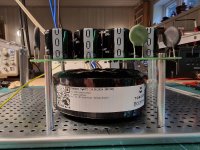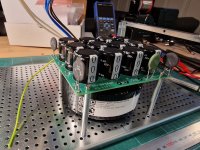If store is going to be out for a while, order straight from modushop. Very fast delivery
The jfets are roughly matched to 1 ma in the range 6 to 8 ma, and the the mosfets about .1v.
The potentiometers manage any differences nicely.
The potentiometers manage any differences nicely.
Does 8-11ma jfet have more gain (and possibly more dynamic sound) than 6-8ma jfet at same supply voltage? Or does it not work that way? TY
Does 8-11ma jfet have more gain (and possibly more dynamic sound) than 6-8ma jfet at same supply voltage? Or does it not work that way? TY
No. That doesn't matter.
It says F5 Turbo v2 has +/-32VDC.
My toroids give me 24-24VAC, I estimate it will give me about 2x31VDC. I think it will be O.K then.
My toroids give me 24-24VAC, I estimate it will give me about 2x31VDC. I think it will be O.K then.
At that voltage you will be running them pretty hard and taking a risk. Quote from F5T manual:
“With respect to voltage, the operating point of these devices is around 30 volts, 5 volts over their rating. In actual testing these devices break down around 43 volts, and I depend on Toshiba's famed conservatism to carry the day. If you don't want to trust Toshiba as much as I do, then you can cascode these devices, which is covered here later.”
“The average dissipation of the Jfets with a 32V supply will be about 28 volts times the operating current. A 2SK170 or 2SJ74 with a 10 mA Idss will operate at about 8 mA in this circuit, which gives a dissipation of about 220 mW. A quick calculation shows that its maximum junction temperature at 220 mW is reached with an ambient temperature of about 70 deg C. A wise DIYer will either select a Jfet with a lesser Idss (say 8 mA) and/or see to it that the Jfets gets some cool air or a little heat sink. Or you can cascode them.” Nelson Pass
“With respect to voltage, the operating point of these devices is around 30 volts, 5 volts over their rating. In actual testing these devices break down around 43 volts, and I depend on Toshiba's famed conservatism to carry the day. If you don't want to trust Toshiba as much as I do, then you can cascode these devices, which is covered here later.”
“The average dissipation of the Jfets with a 32V supply will be about 28 volts times the operating current. A 2SK170 or 2SJ74 with a 10 mA Idss will operate at about 8 mA in this circuit, which gives a dissipation of about 220 mW. A quick calculation shows that its maximum junction temperature at 220 mW is reached with an ambient temperature of about 70 deg C. A wise DIYer will either select a Jfet with a lesser Idss (say 8 mA) and/or see to it that the Jfets gets some cool air or a little heat sink. Or you can cascode them.” Nelson Pass
The kit Idss are more along the lines of 6 ma, so with 25v rails you should see about 120 mw.


LOL Anand. I figured it had to be discussed before, I just didn’t have time to look. Well done.
That looks great, but I'm of the mind that mounting that pot with pins bent (or another variant of the pot, multiturn or not) so that the adjustment screw points upward would have the benefits of an easier access for the screwdriver when adjusting bias, and less potential for the wiring to be in the way. At least I would find it easier to work with a vertical screwdriver out the top, rather than having to get my hands into the chassis. If I build a second F5m, that is what I plan to do.I said "fits the board perfectly" referring to pins vs. PCB holes.
I created my PCBs with the adjustment screws pointing up. I made the adjustments with the cover on, leaving just a gap to insert the screwdrivers.
You could ask Nelson to rotate the trimpots 180 degrees and the 3296P will have its screw pointing up.

You could ask Nelson to rotate the trimpots 180 degrees and the 3296P will have its screw pointing up.
Or there can be small access holes in the cover for the screwdriver,
and the cover can stay fastened in place.
and the cover can stay fastened in place.
I think you forgot that you need to connect the multimeter probes to one of the source resistors in order to make the adjustments.
The test points can be brought out to a connector mounted on the chassis for easy access.
I have done this with tube amps for decades. It's even more important for thermally sensitive ss amps.
I have done this with tube amps for decades. It's even more important for thermally sensitive ss amps.
A lot of people have done this. I haven't heard any complaints
- Home
- Amplifiers
- Pass Labs
- F5m kit

